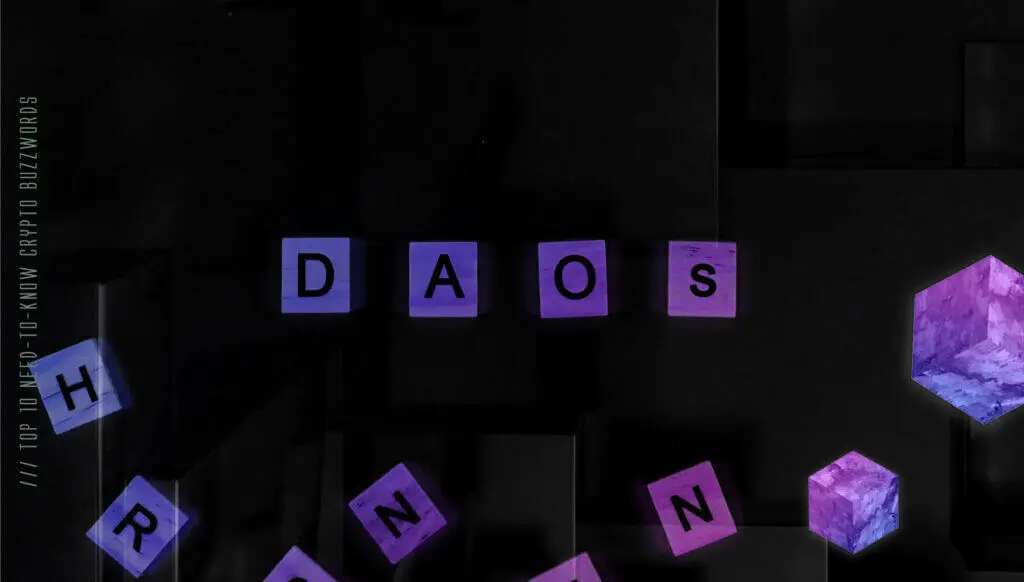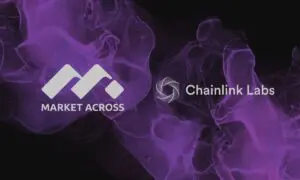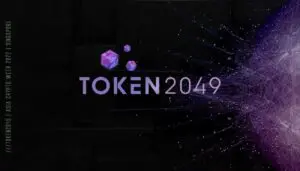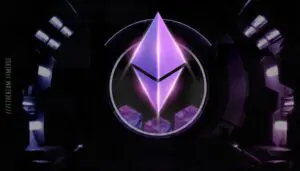
The world of blockchain and cryptocurrencies is constantly evolving. And the same can be said for its lingua franca, the buzzword-laden vocabulary crypto folk use every day. It’s a bizarro language that baffles newcomers and provokes nods of recognition and sneers from those in the know.
Decentralized Autonomous Organizations (DAOs)
DAOs are self-governed organizations that rely on smart contracts to enable transparent, automated and decentralized decision-making. Effectively, these blockchain-governed groups or councils vote on and enact rules which are enforced via smart contracts. Such rules can relate to just about anything. A blockchain game. A decentralized finance protocol. Treasury allocation. Token supply.
Community-driven ventures, DAOs seek to eliminate bureaucracy by returning power to the people. Rather than a centralized, hierarchical system, they distribute authority among members in a decentralized fashion.
Members of a DAO actively participate in decision-making by submitting proposals and voting on them. The voting power of each member is determined by the number of tokens they hold, enabling decentralized governance. This active involvement allows for a more inclusive and democratic approach to organizational management.
Well-known DAOs include MakerDAO, issuer of decentralized stablecoin DAI, and the DAO-based decentralized exchange Uniswap. Proponents argue that DAOs could replace centralized management structures in various industries, from music to finance.
Web3
Web3 is a catch-up term broadly used to describe the next generation of the internet. One that leverages blockchain tech to create a more decentralized, secure and user-centric online ecosystem.
At the heart of the web3 movement is the idea that users will own their own data. And be paid for the content they create. Basically, the web2 internet overlords have been getting fat on the fruit of other people’s labor for too long. The creator economy is taking back control.
Because web3 is such a broad, loose term, it is used almost incessantly by crypto and crypto-adjacent startups. Not least DeFi protocols, blockchain games, decentralized social networks, venture capital firms, metaverses and NFT marketplaces. The web3 world, however, is very much a work in progress.
Proof-of-Stake (PoS)
Proof-of-Stake is a consensus mechanism used in blockchain networks. With PoS, validators are chosen to approve blocks based on their stake in the network rather than their mining ability. The idea is that token-holders are invested in keeping the network secure since they ‘lock’ up their assets as collateral.
PoS aims to replace the energy-intensive Proof-of-Work (PoW) consensus mechanism, reducing energy consumption and enabling scalability. It incentivizes token holders to maintain network integrity since any malicious behavior can lead to a loss of staked tokens. PoS has gained popularity due to its green credentials and efficiency, making it an attractive alternative to
Proof-of-Work.
PoS is the mechanism that underpins Ethereum, one of the oldest and most established blockchain platforms – and currently the busiest. Ethereum completed its transition from PoW to PoS in 2023.
Non-Fungible Tokens (NFTs)
Non-fungible tokens are unique digital assets representing ownership of digital or physical items. A means for creators to monetize their work, NFTs are indivisible and distinguishable from other tokens. And therein lies their value.
Like DAOs, NFTs rely on smart contracts to verify authenticity, ownership, and provenance. Although they purport to cut out the middleman and let creators sell directly to collectors, the reality is somewhat different. Most transactions occur on NFT marketplaces, which benefit from deep liquidity.
NFTs have found applications beyond art, such as in gaming, where they represent virtual real estate and digital commodities. The most valuable NFTs have been digital artworks, with one work selling for $69 million in 2021. 2023, meanwhile, saw the growth of NFT lending protocols, enabling NFT holders to collateralize NFTs to obtain loans. This offshoot of the NFT sector is known as NFT-Finance or NFT-Fi.
Metaverse
The metaverse refers to a virtual reality (VR) world where users can interact with a computer-generated environment. But it is more than just a ‘game’ with a VR component. The metaverse lets users engage in various activities, blurring the physical and digital lines. As well as between game and social network.
Billions of dollars have poured into the metaverse in recent years. Facebook – now known as Meta – is responsible for much of the investment as it transitions into a metaverse company. The technology is seen as key to immersive experiences and social interactions, with users navigating virtual reality via unique avatars. In the metaverse, one can participate in various forms of entertainment (including concerts), commerce, and communication.
Ultimately, the metaverse is envisioned as a shared, interoperable and finite virtual space where we can transcend geographical boundaries. It has captured widespread attention as a potential future internet, offering endless possibilities for entertainment, education and collaboration.
Crypto Twitter
Crypto Twitter is a vibrant online community of cryptocurrency enthusiasts, investors and influencers who share news, insights and memes about crypto.
A corner of the internet dedicated to NFTs, DeFi, blockchain and the wider crypto market, it’s a niche community. One that brings together developers, trading degens, economists, trolls, and anyone keen to debate digital assets.
Characterized by tweetstorms, offbeat humor, irony and a generous serving of schadenfreude, Crypto Twitter is awash with crisscrossing perspectives. As well as pronouncements and predictions about the future of the industry. All in all, it’s a fun place to be.
Utility Token
A utility token is a type of cryptocurrency that serves a specific function within a crypto project’s ecosystem. Rather than operating as typical mediums of exchange, utility tokens play a limited, albeit important role in bolstering community support.
Utility tokens can grant holders voting rights, so they’re often known as governance tokens. In the case of blockchain games, utility tokens can be used to purchase in-game commodities such as NFTs. They can also be dispensed as rewards in play-to-earn games.
Cryptocurrency exchanges, meanwhile, offer users utility tokens as rewards for trading activity. Binance and Uniswap are just two exchanges offering utility tokens, BNB and UNI. All such coins come with their own unique features and benefits.
Tokenomics
Tokenomics refers to the economic system and principles governing a cryptocurrency or token, including distribution, supply and the mechanisms that influence its value.
For example, the asset’s hard cap is 21 million in the case of Bitcoin. This means there will never be more than 21 million bitcoin in circulation. This baked-in scarcity, coupled with gradually increasing demand, can potentially drive the value of BTC higher over time.
Bitcoin’s tokenomics also include a quadrennial halving event which reduces the rate at which new bitcoins are created. The halving mechanism is designed to control inflation and ensure a gradual release of bitcoins into circulation.
Soulbound Tokens
Soulbound tokens (SBTs) are digital assets uniquely tied to a specific individual or organization. They often represent ownership of real-world assets or grant exclusive rights and privileges.
Touted by Ethereum founder Vitalik Buterin in a 2022 blog post, Soulbound tokens are in essence non-transferable NFTs. As Buterin notes, these tokens “have social signaling value” since they represent endeavor and often ingenuity. Whereas regular NFTs often signal wealth and status.
The potential use-cases of Soulbound tokens are numerous. They can prove NFT provenance, provide a digital employment record and a digital medical history. They could also be used to prove a user has completed KYC, saving the hassle of completing further forms.
Meme Coins
Meme coins are cryptocurrencies that gain popularity primarily through online communities and social media, often driven by humorous or satirical content.
Although meme coins have no inherent utility or value, their popularity often propels them into the cryptocurrency rankings. Dogecoin, the meme coin championed by Tesla boss Elon Musk, is the perfect example with a market capitalization of $10 billion. Another meme token, Pepecoin, trades at a fraction of a cent yet recently hit a market cap of $1.6 billion.
Meme coins are often the talk of Crypto Twitter and many community members delight in documenting their rise and fall. While meme coins are arguably amusing, trading meme coins is risky business. As always, the golden rule is DYOR!
In the ever-evolving landscape, keeping up-to-date with the aforementioned crypto buzzwords will help you navigate and, more importantly, comprehend the latest goings-on in this weird and wacky sector. When they tell you there’s never a dull day in crypto, believe me, they mean it.




















